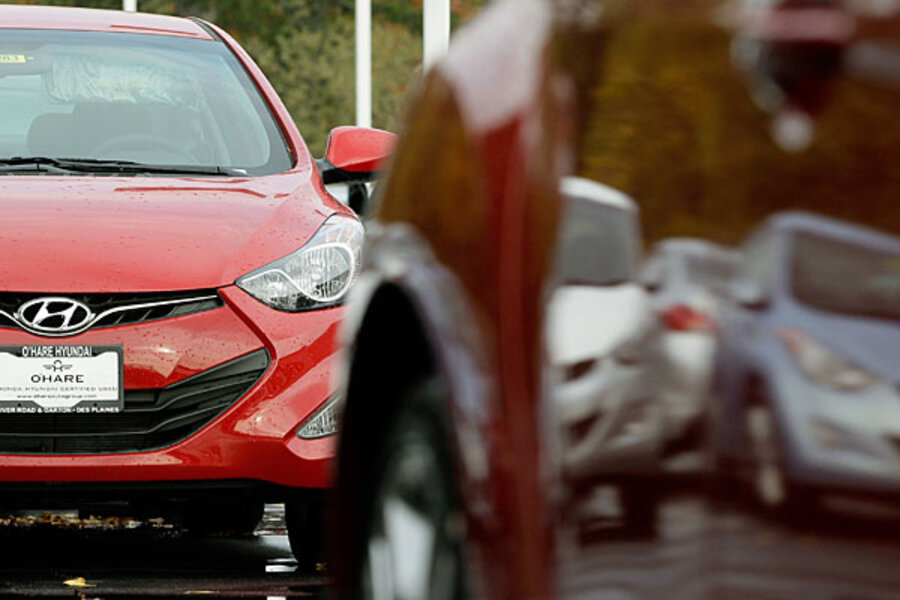Hyundai, Kia overstated mileage, EPA finds. What it means for consumers
Loading...
| Chicago
Hyundai Motors America and Kia Motors America are being forced to lower the fuel economy estimates on the majority of their 2012-13 models after an investigation by the Environmental Protection Agency found that the companies overstated the fuel efficiency numbers for their vehicles in previous years.
Automotive industry analysts are calling the scale of the corrective move unprecedented.
Discovery of the exaggerated claims is also requiring that the companies, subsidiaries of the same Korean corporate parent, compensate the owners of least 900,000 2011-to-2013 model-year vehicles sold through Wednesday. According to one preliminary estimate, the reimbursement program is expected to cost the two companies tens of millions of dollars.
On average, the companies misstated the fuel economy of their new vehicle fleets by 3 percent. The mileage for most vehicles will be reduced by up to two miles per gallon, although the largest reduction will be six highway miles per gallon for the Kia Soul.
While m.p.g. discrepancies have been discovered in the past, the EPA says, “this is the first time where a large number of vehicles from the same manufacturer have deviated so significantly.”
“Consumers rely on the window sticker to help make informed choices about the cars they buy,” Gina McCarthy, assistant administrator for the EPA’s Office of Air and Radiation, said in a statement. “EPA’s investigation will help protect consumers and ensure a level playing field among automakers.”
New window stickers for the remaining vehicles on dealership lots are being affixed starting Friday.
Both companies collectively blame the discrepancy on “procedural errors” at their joint testing operations in Korea.
In a statement released Friday, W.C. Yang, chief technology officer of Hyundai/Kia research and development, said, “I sincerely apologize to all affected Hyundai and Kia customers, and I regret these errors occurred. Following up on the EPA’s audit results, we have taken immediate action to make the necessary rating changes and process corrections.”
The EPA says it has not ruled out civil penalties, and the scenario leaves open the possibility of a Federal Trade Commission investigation to seek whether the company used the overstated fuel efficiency ratings in its advertising.
Besides the possible fines and millions the company is expected to pay out to its buyers, another expected fallout will be consumer trust, says John O’Dell, the senior green car editor at Edmunds.com, an automotive research outlet in Santa Monica, Calif.
“Whether an honest mistake or a deliberate corporate effort to fudge the numbers, the fact that the companies’ ballyhooed 40-m.p.g. cars are no longer members of that august club ... will be something that haunts the companies for a long time to come. In an industry where reputation is so important, this will undoubtedly give both carmakers ugly black eyes,” Mr. O’Dell says.
The disciplinary action comes at an especially sensitive time for the automotive industry, which is responding to the consumer need for more fuel efficient vehicles, especially with gas prices spiking above $4 a gallon in some markets, and to the stricter federal fuel efficiency standards announced by the Obama administration in August.
The new standards require an increase in fuel economy to an average of 54.5 m.p.g. for cars and light trucks by model year 2025. The improved standards are a continuation of recent regulations requiring that automobile manufacturers car fleets reach an average of 35.5 m.p.g. by 2016.
Already fuel efficiency has improved industry-wide, with average fuel efficiency for a new vehicle increasing from 30.1 m.p.g. in 2006 to 33.8 m.p.g. in 2011, a more than 10 percent improvement, according to the US Department of Transportation. Edmunds.com reports that only a handful of non-hybrid vehicles currently can tout a 40 m.p.g. rating.
Under the reimbursement program, Hyundai and Kia will compensate vehicle owners for the lower gas mileage by instructing them to bring their vehicles into dealerships. The odometer will be checked to calculate how much gas would have been saved had the car achieved the mileage the original window sticker promised. The companies said they would add 15 percent to the reimbursement amount.
More information is available on the websites HyundaiMPGinfo.com and KiaMPGinfo.com.








